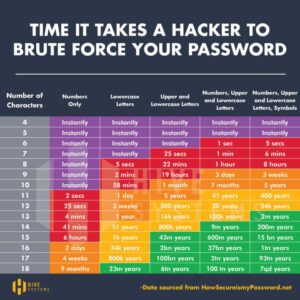What steps are you taking to protect your data—and your clients’ data—more efficiently? One of the best ways to put cybersecurity first is by developing strong passwords and better security habits. Your passwords are your first and best defense against threat actors. Here are some tips to up your game that you can implement today!
1. Status: It is Complicated
Think of your favorite heist movie. For this piece, we are thinking of The Italian Job. In it, Charlize Theron plays the team’s safecracker. She used several tools and skills to guess the combination to the safe, switching and turning the dial until she found the right sequence of numbers to get inside. Our passwords are like the combination on a safe. The more complicated the combination, the longer it will take Charlize Theron to get in, or in this case, a threat actor. Check out the chart below.

It looks like a lot, but we are here to break it all down for you!
A simple password may be easy to remember, but it also shortens the time it takes to guess the right “combination.” If you can use more than just numbers, such as varying letter cases and characters, it will take longer for threat actors to crack the code. So, that is your first tip: keep it complicated, not simple.
2. Case by Case
If you find it hard to keep track of numbers for your passwords, consider using upper- and lowercase letters. This is not a foolproof plan, but it can make the threat actors’ efforts more challenging. Regardless, you should update your passwords regularly. Just a heads up: relying on upper- and lowercase letters alone may require you to do so more often.
3. The Numbers do not Lie
If you have started adding upper- and lowercase letters to your passwords, rethink how you can use numbers, too. Try to avoid any numbers that are important to you, like adding your birthday or an anniversary at the end of your password.
4. A Character’s Good Reputation
Now that you have a few security boosters in your passwords, consider using more characters, such as @, #, $, %, !, and more. They are all waiting at the top of your keyboard to add an extra layer of defense to your passwords. Special characters are powerhouses when it comes to building strong passwords.
5. Phrasing!
Finally, bring all these strategies together. You can use any combination of letter cases, numbers, and special characters to spell out one word, or you can get really creative and create a “passphrase.” A passphrase is a short sentence comprised of all the elements covered above. Phrases such as 13@kEm0re8reaD or j0G1m!le are examples of passphrases. They can be reminders, goals, or items from your to-do list. While passphrases stand above the rest, make sure they are not too obvious or relevant to your personal life, such as specific hobbies, favorite movies, or loved ones.
YOU HAVE CRACKED THE PASSWORD CODE!
By creating strong passwords, you are going the extra mile to put cybersecurity best practices first. The more complicated the better—just make sure you leave no physical reminders behind, and that you update your passwords regularly. Multi-factor authentication (or MFA) is another excellent feature you can apply to your devices. When you start implementing safe and modern password best practices into your day-to-day life, you protect your organization, your data, and yourself!
You can learn more about cybersecurity practices and management by checking out our OnGuard Security Awareness Program!